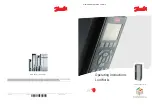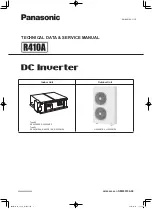
SIEPCYEUOQ2V01A Q2V Technical Manual
469
Use the PID feedback loss detection function when you use PID control. If the feedback signal is too low, the
motor can suddenly accelerate to the maximum output frequency. This function prevents such risks to the load.
The drive uses two methods to detect feedback loss:
•
PID Feedback Loss [FbL]
Set these parameters for the PID feedback loss detection function.
The drive detects feedback loss when the feedback value is less than the value in
b5-13
for longer than the time
in
b5-14
.
–
b5-12 [Fdback Loss Select Mode]
–
b5-13 [Fdback Loss Lvl]
–
b5-14 [Fdback Loss Time]
•
Excessive PID Feedback [FbH]
Set these parameters to set how the drive detects a feedback level that is too high.
The drive detects too much PID feedback when the feedback value is more than the value in
b5-36
for longer
than the time in
b5-37
.
–
b5-12 [Fdback Loss Select Mode]
–
b5-36 [PID HiHi Limit Level]
–
b5-37 [PID HiHi Time]
This figure shows the operation principle when the feedback value is too low, and the drive detects feedback loss.
The operation is the same when the drive detects too much feedback.
Figure 12.30 Time Chart for PID Feedback Loss Detection Time
■
PID Sleep
PID sleep stops drive operation when the PID output or the frequency reference is less than
b5-15 [Sleep Start
Level]
. This function shuts off drive output after the motor decelerates to the set frequency.
The drive will automatically restart the motor when the PID output or the frequency reference is more than the
b5-
15
value for the time set in
b5-16 [Sleep Delay Time]
.
This figure shows the PID Sleep function.
Figure 12.31 PID Sleep Time Chart
Note:
•
The PID Sleep function is enabled when PID control is disabled.
•
When the PID Sleep function is triggered, the drive will stop the motor as specified by
b1-03 [Stopping Method Selection]
.
■
Fine-Tuning PID
Fine-tune the following parameter settings to have PID control eliminate problems with overshoot and oscillation.
•
b5-02 [Proportional Gain (P)]
Summary of Contents for Q2V Series
Page 2: ...This Page Intentionally Blank 2 SIEPCYEUOQ2V01A Q2V Technical Manual...
Page 12: ...12 SIEPCYEUOQ2V01A Q2V Technical Manual...
Page 18: ...i 2 Legal Information 18 SIEPCYEUOQ2V01A Q2V Technical Manual...
Page 26: ...1 2 Features and Advantages of Control Methods 26 SIEPCYEUOQ2V01A Q2V Technical Manual...
Page 38: ...2 8 Installation Methods 38 SIEPCYEUOQ2V01A Q2V Technical Manual...
Page 70: ...3 3 Main Circuit Wiring 70 SIEPCYEUOQ2V01A Q2V Technical Manual Models B006 B012...
Page 102: ...3 17 Motor Application Precautions 102 SIEPCYEUOQ2V01A Q2V Technical Manual...
Page 138: ...4 12 Test Run Checklist 138 SIEPCYEUOQ2V01A Q2V Technical Manual...
Page 144: ...5 2 European Standards 144 SIEPCYEUOQ2V01A Q2V Technical Manual...
Page 145: ...Standards Compliance 5 5 2 European Standards SIEPCYEUOQ2V01A Q2V Technical Manual 145...
Page 146: ...5 2 European Standards 146 SIEPCYEUOQ2V01A Q2V Technical Manual...
Page 266: ...7 10 Troubleshooting Without Fault Display 266 SIEPCYEUOQ2V01A Q2V Technical Manual...
Page 284: ...8 6 Storage Guidelines 284 SIEPCYEUOQ2V01A Q2V Technical Manual...
Page 312: ...10 10 Peripheral Devices and Options 312 SIEPCYEUOQ2V01A Q2V Technical Manual...
Page 430: ...11 21 Parameters Changed by PM Motor Code Selection 430 SIEPCYEUOQ2V01A Q2V Technical Manual...
Page 731: ...SIEPCYEUOQ2V01A Q2V Technical Manual 731 Z Z pulse Auto Tuning 125...
















































